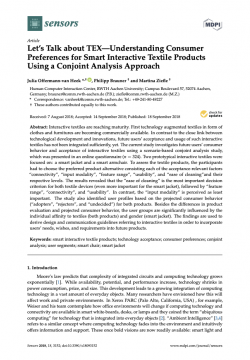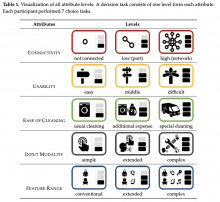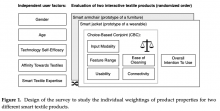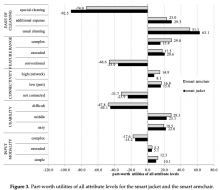
Abstract
Interactive textiles are reaching maturity. First technology augmented textiles in form of clothes and furnitures are becoming commercially available. In contrast to the close link between technological development and innovations, future users’ acceptance and usage of such interactive textiles has not been integrated sufficiently, yet. The current study investigates future users’ consumer behavior and acceptance of interactive textiles using a scenario-based conjoint analysis study, which was presented in an online questionnaire ( n = 324 ). Two prototypical interactive textiles were focused on: a smart jacket and a smart armchair. To assess the textile products, the participants had to choose the preferred product alternative consisting each of the acceptance-relevant factors “connectivity”, “input modality”, “feature range”, “usability”, and “ease of cleaning”and their respective levels. The results revealed that the “ease of cleaning” is the most important decision criterion for both textile devices (even more important for the smart jacket), followed by “feature range”, “connectivity”, and “usability”. In contrast, the “input modality” is perceived as least important. The study also identified user profiles based on the projected consumer behavior (“adopters”, “rejecters”, and “undecided”) for both products. Besides the differences in product evaluation and projected consumer behavior, the user groups are significantly influenced by the individual affinity to textiles (both products) and gender (smart jacket). The findings are used to derive design and communication guidelines referring to interactive textiles in order to incorporate users’ needs, wishes, and requirements into future products.
Offermann-Van Heek, J., Brauner, P., Ziefle, M.: Let’s talk about TEX—Understanding consumer preferences for smart interactive textile products using a conjoint analysis approach. Sensors. 18, (2018).
Related Project(s):


